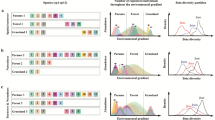Abstract
The hoverfly fauna of the northwestern Caucasus comprises 257 species of 72 genera. They possess 32 types of ranges that could be united into 11 groups of ranges. Widespread species from the basis of the hoverfly fauna in the region: species with narrower ranges, those distributed in more than one zoogeographical region, and those distributed in more than one dominion, constitute 12.9%, 63.1%, and 24% of the fauna, respectively. The hoverfly fauna of the northwestern Caucasus is composed of nemoral species common for Europe and Mediterranean basin, and also by species widespread in the Palaearctic (92.9%). Autochthomous species constitute 5.5%, and species of the eastern Palaearctic origin, 1.6%. Hoverfly species with zoophagous larvae are the most widespread. The fraction of such species is low among species with narrowly local ranges (12.5%) and high among species with ranges including more than one dominion. Phytophagous species are wider represented among hoverflies with narrowly local ranges (44.7%) than among flies with interdominion ranges (8%). Ranges of dendrobiontic saprophagous species are determined by the presence of arboreal vegetation and no widespread polytopic hoverflies are found in this group. The distribution of mycetophagous species, commensals, and terrestrial saprophagous species is determined by the presence of fungi, ranges of some hymenopterans, and the presence of decaying plant remnants.
Similar content being viewed by others
References
Barkalov, A.V. “Hoverflies of the Genus Cheilosia Meigen, 1822 (Diptera, Syrphidae) of the Caucasus,” Entomol. Obozr. 72(3), 698–727 (1993).
Emeljanov, A.F., “Suggestions on the Classification and Nomenclature of Geographical Ranges,” Entomol. Obozr. 53(3) 497–522 (1974).
Krivokhatsky, V.A., Zoogeography of Ant Lions of the Palaearctic Region (Neuroptera, Myrmeleontidae). Readings in Memoriam of N.A. Kholodkovsky (Nauka, St. Petersburg, 1998) [in Russian].
Kryzhanovskij, O.L., The Composition and Origin of the Terrestrial Fauna of Middle Asia (Nauka, Leningrad, 1965) [in Russian].
Kryzhanovskij, O.L. Composition and Distribution of Entomofaunas of the Globe (KMK, Moscow, 2002) [in Russian].
Kuznetsov, S.Yu. “Hoverflies of the Genus Scaeva Fabricius (Diptera, Syrphidae) of the Fauna of the Palaearctic Region,” Entomol. Obozr. 64(2), 398–418 (1985).
Kuznetsov, S.Yu., “The Phylogeny of the Family Syrphidae (Diptera),” in Proceedings of the 12th Congress of Russian Entomological Society, August 19–24, 2002 (Nauka, St. Petersburg, 2002), p. 189.
Kuznetsov, S.Yu. and Kustov, S.Yu., “A Contribution to the Fauna of Krasnodar Territory (Diptera, Syrphidae),” Dipterol. Res. 11(4), 181–199 (1968).
Lavrenko, E.M., The Main Features of the Botanic Geography of Deserts of Eurasia and Northern Africa (Nauka, Moscow, 1962) [in Russian].
Mutin, V.A. and Barkalov, A.V., “Family Syrphidae or Hoverflies,” in A Key to Insects of the Russian Far East (1999), Vol. 6, Part 1, pp. 342–500 [in Russian].
Peck, L.V., “Syrphidae,” in Catalogue of Palaearctic Diptera, Ed. by A. Soos and L. Papp (1988), Vol. 8, pp. 11–230.
Ranges of Insects of the European USSR. An Atlas (Nauka, Leningrad, 1984) [in Russian].
Rikli, M. Das Pflantsenkleid der Mittelmeerländer I, II, III (Bern, 1943, 1946, 1948).
Semenov Tyan-Shanskii, A.P., Limits and Zoogeographical Subdivisions of the Palaearctic Region for Terrestrial Animals on the Basis of Zoogeographical Distribution of Coleopteran Insects (Nauka, Moscow, 1936) [in Russian].
Shiffers, E.V., Vegetation of the Northern Caucasus and Its Natural Trophic Resources (Moscow, 1953) [in Russian].
Skufjin, K.V., “Contributions to the Fauna of Hoverflies (Diptera, Syrphidae) of the Caucasian State Reserve,” Trudy Voronezh. Gos. Zapovednika 15, 50–66 (1967).
Skufjin, K.V., “New Species of Hoverflies (Diptera, Syrphidae) from the Northern Caucasus,” Entomol. Obozr. 55(4), 931–934 (1976).
Skufjin, K.V. and Lysenko, N.N., “New Data on the Hoverfly Fauna (Diptera, Syrphidae) of the Caucasian State Reserve,” in Problems of Study and Preservation of Landscapes (Voronezh, 1975), pp. 55–59.
Stackelberg, A.A. and Richter, V.A., “A Contribution to the Hoverfly Fauna Diptera, Syrphidae) of the Caucasus,” Trudy Vses. Entomol. O-va 52, 224–274 (1968).
Takhtadjan, A.L. Floristic Communities of the Earth (Nauka, Leningrad, 1978) [in Russian].
Vereshchagin, N.K. “Zoogeographical Zoning of the Caucasian Isthmus,” in The Animal World of the USSR (Nauka, Moscow, 1958), Vol. 5, pp. 506–517.
Zimina, L.V., “Rare and Interesting Syrphidae (Diptera) in the Collection of the Zoological Museum, Moscow State University,” Sbornik Trudov Zool. Muz. MGU 15, 136–148 (1975).
Author information
Authors and Affiliations
Additional information
Original Russian Text © S. Yu. Kustov, 2006, published in Entomologicheskoe Obozrenie, 2006, Vol. 85, No. 1, pp. 54–74.
Rights and permissions
About this article
Cite this article
Kustov, S.Y. Zoogeographical analysis of the hoverfly fauna (Diptera, Syrphidae) of the northwestern Caucasus. Entmol. Rev. 86, 188–196 (2006). https://doi.org/10.1134/S0013873806020072
Received:
Issue Date:
DOI: https://doi.org/10.1134/S0013873806020072



